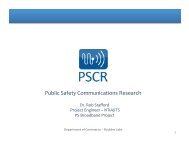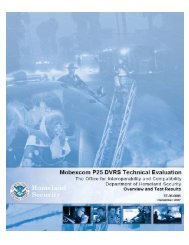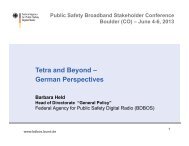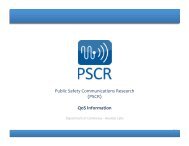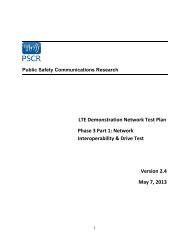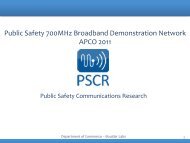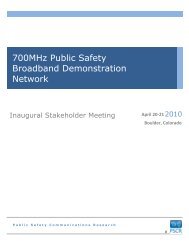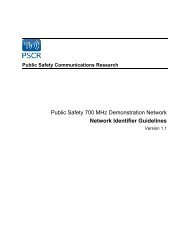Launch Requirements - PSCR
Launch Requirements - PSCR
Launch Requirements - PSCR
Create successful ePaper yourself
Turn your PDF publications into a flip-book with our unique Google optimized e-Paper software.
Policies and Procedures<br />
Public Safety Broadband<br />
Prioritization in the NPSBN must ensure that high-‐priority users can establish connections with a high <br />
level of certainty relative to low-‐priority users. Priority levels for connections may be defined and <br />
assigned based on various criteria including the user’s role, user application types, or incident type. In <br />
addition, public safety applications such as Computer Aided Dispatch (CAD), Incident Command System <br />
(ICS), Next-‐Generation 9-‐1-‐1 (NG9-‐1-‐1), and other applications that require QoS support for their proper <br />
operation will require standardized mechanisms to inform the network of the prioritization and QoS <br />
attributes of these IP packet streams. <br />
Although the technical aspects associated with management of priority and QoS on an LTE network are <br />
standardized, the dynamic factors associated with incident management prevent a simple consistent <br />
approach to dynamically assigning priority based on a user’s role in an incident. It is typically not <br />
possible to predict which user or how often an agency must have the highest priority at any particular <br />
moment. <br />
The NPSTC Priority and QoS Working Group identified two public safety network services that must have <br />
high priorities: responder emergency and immediate peril [4]. Further categories are defined in Section <br />
6 including ICS Incident Priority and Itinerant User. Therefore, the NPSBN should utilize a base <br />
nationwide priority scheme for users and applications on the network. The priority scheme must reserve <br />
the highest levels of priority for the applications mentioned above (responder emergency and <br />
immediate peril). Nothing on the network should have a higher priority. Below those two levels, NPSTC <br />
recommends that FirstNet establish priorities for operational units of law enforcement, fire, EMS, and <br />
emergency management agencies. The priorities for the operational elements of these four services <br />
should be consistent across the network. <br />
The lowest network priorities must be reserved for those users who lease the spectrum for commercial <br />
and/or personal use. Although assigned to the lowest system priorities, these users will typically not <br />
experience any performance limitations unless a major public safety event is active in the same cell <br />
sector. Following are requirements for user prioritization. <br />
Table 6. User Prioritization <strong>Requirements</strong><br />
# Requirement<br />
1 FirstNet SHALL develop a policy for the NPSBN that requires a nationwide standard for <br />
prioritization and QoS. <br />
2 FirstNet SHALL define the default priorities of all user classes on the NPSBN. <br />
3 FirstNet SHALL establish a policy whereby public safety applications such as CAD, ICS, and <br />
other applications that require QoS support for their proper operation will utilize standardized <br />
mechanisms to inform the network of the prioritization and QoS attributes of these IP packet <br />
streams. <br />
10 <strong>Launch</strong> Statement of <strong>Requirements</strong><br />
for FirstNet Consideration, December 2012






